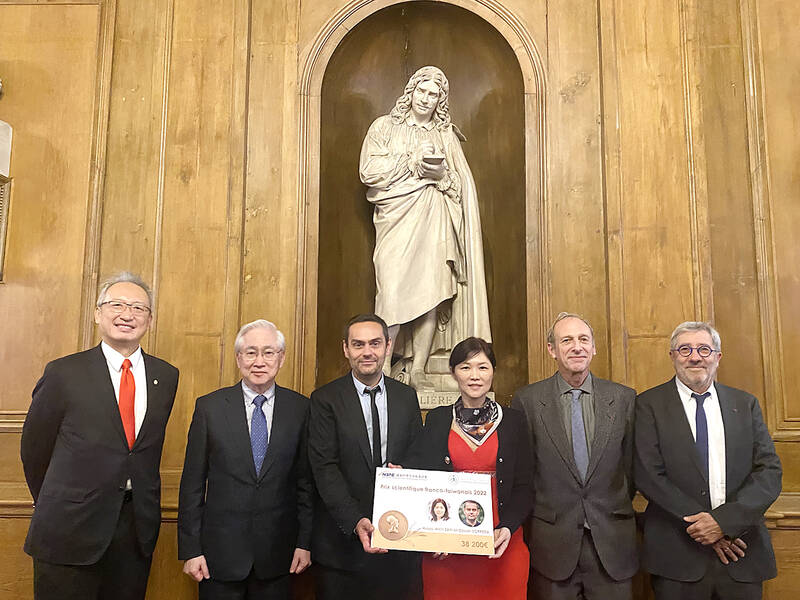Zan Hsiao-wen (冉曉雯) and Olivier Soppera on Wednesday received this year’s Franco-Taiwanese Scientific Grand Prize in Paris for their joint development of a semiconductor metal oxide gas sensor for use in medical applications.
Zan, a professor at National Yang Ming Chiao Tung University’s Department of Photonics, specializes in optoelectronic semiconductor components, and has been devoted to organic and oxide semiconductor research for more than 25 years.
She also chairs the women’s engineering group at the Taiwan branch of the Institute of Electrical and Electronics Engineers (IEEE), and holds more than 80 patents for inventions pertaining to novel structural semiconductor devices.

Photo: CNA
Soppera, the head researcher of the Mulhouse Materials Science Institute at the French National Centre for Scientific Research, is an expert on the development of photo materials for micro- and nanofabrication.
The metal oxide gas sensor is based on the Internet of Things and can detect ammonia in breath, the researchers said.
In 2019, Zan proved through animal and human trials that exhaled ammonia is a useful biomarker for predicting kidney function in people with chronic kidney disease.
Zan said the award meant a lot to them as their field of research is not considered mainstream.
“It took a lot of effort, from the development of components to testing and application,” she said, adding that their goal had been to produce something useful to society.
The French researcher also expressed his excitement about the honor and praised the collaboration between France and Taiwan.
Soppera said his research with Zan would continue, as there are still many new projects in the works that would hopefully improve people’s lives.
The award carries a cash prize of 38,200 euros (US$39,738).
The Franco-Taiwanese Scientific Grand Prize, founded in 1999, is an annual award for researchers in France and Taiwan. It can be awarded to scientists in any field, but prioritizes research that facilitates collaboration between Taiwan and France.

The brilliant blue waters, thick foliage and bucolic atmosphere on this seemingly idyllic archipelago deep in the Pacific Ocean belie the key role it now plays in a titanic geopolitical struggle. Palau is again on the front line as China, and the US and its allies prepare their forces in an intensifying contest for control over the Asia-Pacific region. The democratic nation of just 17,000 people hosts US-controlled airstrips and soon-to-be-completed radar installations that the US military describes as “critical” to monitoring vast swathes of water and airspace. It is also a key piece of the second island chain, a string of

A magnitude 5.9 earthquake that struck about 33km off the coast of Hualien City was the "main shock" in a series of quakes in the area, with aftershocks expected over the next three days, the Central Weather Administration (CWA) said yesterday. Prior to the magnitude 5.9 quake shaking most of Taiwan at 6:53pm yesterday, six other earthquakes stronger than a magnitude of 4, starting with a magnitude 5.5 quake at 6:09pm, occurred in the area. CWA Seismological Center Director Wu Chien-fu (吳健富) confirmed that the quakes were all part of the same series and that the magnitude 5.5 temblor was

Taiwan will now have four additional national holidays after the Legislative Yuan passed an amendment today, which also made Labor Day a national holiday for all sectors. The Chinese Nationalist Party (KMT) and Taiwan People’s Party (TPP) used their majority in the Legislative Yuan to pass the amendment to the Act on Implementing Memorial Days and State Holidays (紀念日及節日實施辦法), which the parties jointly proposed, in its third and final reading today. The legislature passed the bill to amend the act, which is currently enforced administratively, raising it to the legal level. The new legislation recognizes Confucius’ birthday on Sept. 28, the

The Central Weather Administration has issued a heat alert for southeastern Taiwan, warning of temperatures as high as 36°C today, while alerting some coastal areas of strong winds later in the day. Kaohsiung’s Neimen District (內門) and Pingtung County’s Neipu Township (內埔) are under an orange heat alert, which warns of temperatures as high as 36°C for three consecutive days, the CWA said, citing southwest winds. The heat would also extend to Tainan’s Nansi (楠西) and Yujing (玉井) districts, as well as Pingtung’s Gaoshu (高樹), Yanpu (鹽埔) and Majia (瑪家) townships, it said, forecasting highs of up to 36°C in those areas